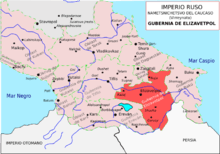Elisabethpol Governorate
| Elisabethpol Governorate (in English) | ||
|---|---|---|
| ||
 | ||
| ||
| Established | 1868 | |
| Abolished | 1917 | |
| Political status | Governorate | |
| Region | Caucasus | |
| Area | 38,782.5 verst² | |
| Population (1897 census) | ||
| • Total | 878415 | |
| • Density | 22.6 inhab. / verst² | |
| • Urban | 10.16% | |
| • Rural | 89.84% | |
| Government | ||
| Wikisource has the text of the 1911 Encyclopædia Britannica article Elisavetpol. |
Elisabethpol Governorate or Elizavetpol Governorate or Elizavetapol Governorate (Russian: Елизаветпольская губерния; in pre-1918 Russian spelling: Елисаветпольская губернія) was one of the guberniyas of the Caucasus Viceroyalty of the Russian Empire, with its centre in Elisabethpol (official name for Ganja in 1805–1918). Its area was 44,136 sq. kilometres,[1] and it had 878,415 inhabitants by 1897.[2]
History
Elisabethpol Governorate was created in 1868 from parts of Baku Governorate and Tiflis Governorate. This included lands of the former Ganja Khanate, Shaki Khanate, and Karabakh Khanate. It bordered with Baku Governorate, Tiflis Governorate, Yerevan Governorate, Dagestan Oblast, and Persia.
Starting in 1905, there were attempts by the region's ethnic Armenians to separate the highland areas (commonly known as Mountainous Karabagh) from the rest of Elisabethpol. Another attempt to create an independent Armenian state in the region was the Republic of Mountainous Armenia in 1921.
On the establishment of the Azerbaijan Democratic Republic in 1918, Elisabethpol Governorate was renamed Ganja Governorate. The area to the south of the Murov Range was made into Karabakh Governorate General. The governorate system was abolished in the early 1920s.
Today, the territory of the former Elisabethpol Governorate is in western Azerbaijan and adjacent areas of Armenia.
Administrative division
Elisabethpol Governorate was originally divided into eight uyezds:[1]
Demographics
The 1886 population estimate was 728,943, living in 3 cities (Elisabethpol, Nukha, and Shusha) and 1521 villages. [3]
According to the 1897 census, the total population was 878,415. Tatars at 534,086 (60.8%) and Armenians at 292,188 (33.3%) were the largest ethnic groups. Other ethnic groups included Lezgins (14,503 or 1.7%; reported at the time as Кюринцы and Гапутлинцы ), Russians (14,146 or 1.6%), Udis (7,040 or 0.8%), Germans (3,194 or 0.4%) and Kurds (3,042 or 0.3%).
According to 1886 statistics reported in Brockhaus and Efron Encyclopedic Dictionary,[3] the Orthodox Christians constituted 0.21% of the Governorate's population, and various "sectarians" (сектанты) around 1% (i.e., some 7,300 people). This means that most of the ethnic Russians in the Governorate at the time (1.11% of the Governorate's 728,943 population in 1886) were members of various dissenter communities, such as Doukhobors and Molokans.
Ethnic groups in 1897
Source:[4]
| Uyezd | Tatars | Armenians | Lezgins | Russians | Belarusians | Germans | Kurds | Udis |
|---|---|---|---|---|---|---|---|---|
| TOTAL | 60.8% | 33.3% | 1.7% | 1.6% | ... | ... | ... | ... |
| Aresh | 70.1% | 20.5% | 8.7% | ... | ... | ... | ... | ... |
| Jebrayil | 74.1% | 23.7% | ... | 1.1% | ... | ... | ... | ... |
| Javanshir | 71.6% | 26.9% | ... | ... | ... | ... | ... | ... |
| Elisabethpol | 63.9% | 26.4% | ... | 4.4% | 1.7% | 1.9% | ... | ... |
| Zangezur | 51.6% | 46.1% | ... | ... | ... | ... | 1.3% | ... |
| Kazakh | 57.2% | 38.9% | ... | 3.0% | ... | ... | ... | ... |
| Nukha | 69.3% | 15.7% | 7.1% | ... | ... | ... | ... | 5.8% |
| Shusha | 45.3% | 53.3% | ... | 1.0% | ... | ... | ... | ... |
Known governors
- Fokion Bulatov, 1868–1876
- Alexander Nakashidze, 1880–1897
- Ivan Kireyev, 1897–1900
- Nikolai Lutsau, 1900–1905
- Yegor Baranovsky, 1905 (acting)
- Alexander Kalachev, 1905–1907
- Samkalov, 1907–1908
- Georgi Kovalev, 1908–1916
- Mikhail Poyarkov, 1916–1917[5]
References
- 1 2 (in Russian) Brockhaus and Efron Encyclopaedia: Elisabethpol Governorate
- ↑ (in Russian) Brockhaus and Efron Encyclopaedia: Elisabethpol Governorate – additional information to the article
- 1 2 Елизаветпольская губерния (Elizavetpol Governorate) in Brockhaus and Efron Encyclopedic Dictionary (in Russian)
- ↑ Демоскоп Weekly - Первая всеобщая перепись населения Российской Империи 1897 г. Распределение населения по родному языку и уездам. Российской Империи кроме губерний Европейской России
- ↑ Lands of Ganja Archived 2011-07-18 at the Wayback Machine.
